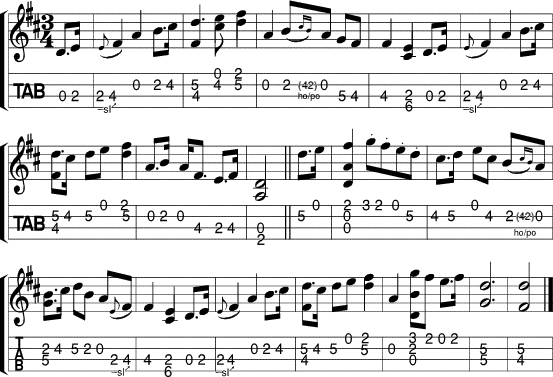The Yellow Haired Laddie 2 |
I always feel that it's better to play a tune simply and well than with lots of decoration but badly. It's only when you have confidence with a tune that you can start adding decorations, but it's as well to start practising such decorative techniques now. We're going to look at a tune in detail, an old Scots tune called The Yellow Haired Laddie, which has been used for a few songs since the 17th century. Also known as The Brown Haired Boy.
A detailed bar-by-bar description of this arrangement is at the foot of this page, and it is also available as a [MIDI file]. A simpler, no-frills version of Yellow Haired Laddie can be seen here.
Back to The Scottish Mandolin >> Improvers Mandolin

A PART
Lead in notes The second note is an E, second fret on the D string. Normally this would be fretted with the index finger, but because we're going to be sliding up to the fourth fret, play the E with your middle finger.
Bar 1 Slide your middle finger up from the second fret to the fourth. Use a bit of strength and keep the note ringing while you strike the open A string.
Bar 2 We're going to use double stops on all three notes in the second bar.
Bar 3 We're using a decoration here which is called a turn in Scottish fiddling terms, and it's really a hammer-on and double pull-off. When you play the B note (second fret A string) quickly hammer on to the fourth fret, then pull off back to the B, and pull of immediately down to the A. At first you might be disappointed with your lack of sustain, but it should improve with practice.
Bar 4 A simple double-stop.
Bar 8 Because we're finishing on the root note (the tune is in D, and we're finishing on a D note) we want to give it some strength, so play a low A along with it.
B PART
Bar 1 To give it more of a flourish we're not using a typical double stop here, but playing the open A and the open D strings with the F# on the E string. When we play the run down immediately afterwards, I like to play each note cleanly and separately.
Bar 2 Hammer-on and double pull-off again, just like bar3 in the A part.
Bar 3 The last note in the bar is an F#, fourth fret on the D string, but we're going to slide up from the second fret, so use your middle finger on the second fret and slide up.
Bar 7 The high g (third fret on the E string) benefits from a flourish, so form a G chord and play three or four strings to give it something extra.
Bars 8 & 9 I like to finish the tune with a wistful note, so instead of "resolving" (finishing on the notes that are expected) I play the fifth fret of both the A string and the D string before finally resolving in the last bar.